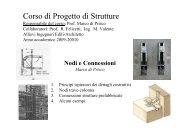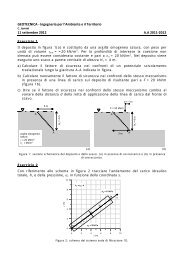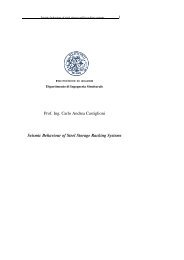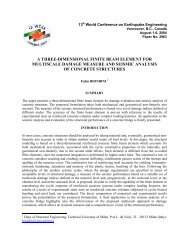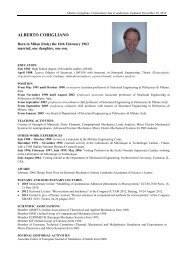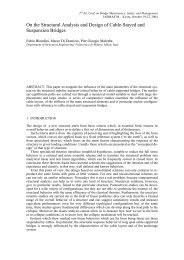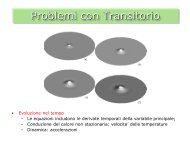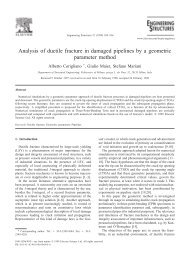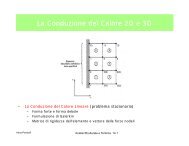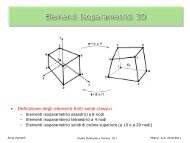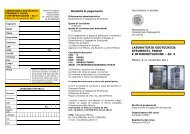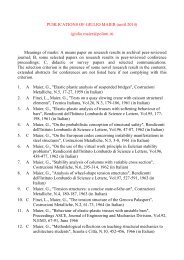Finite Strip Modeling for Optimal Design of Folded Plate Structures
Finite Strip Modeling for Optimal Design of Folded Plate Structures
Finite Strip Modeling for Optimal Design of Folded Plate Structures
You also want an ePaper? Increase the reach of your titles
YUMPU automatically turns print PDFs into web optimized ePapers that Google loves.
1046 A. Bergamini, F. Biondini / Engineering <strong>Structures</strong> 26 (2004) 1043–1054finite strips. In particular, by assuming the thickness<strong>of</strong> each plate as linearly varying, the thickness valuesat the nodal lines completely define the thickness distributionover the whole structure.– The structural topology depends on the mutualarrangement <strong>of</strong> the strips. In this sense, several alternativestructural topologies, <strong>for</strong> example, identifiedthrough an integer variable, needto be consideredduring the design process. This can be done bybuilding a family <strong>of</strong> derived topologies by the elimination<strong>of</strong> one or more folded plates from a given basictopology.– The prestressing system is representedby a set <strong>of</strong>post-tensionedcables at one or both <strong>of</strong> their endsandit is fully definedby the intensity <strong>of</strong> the prestressing<strong>for</strong>ces andby the longitudinal pr<strong>of</strong>ile <strong>of</strong> thecables. In this study, the curvilinear pr<strong>of</strong>ile <strong>of</strong> thecables is described by means <strong>of</strong> Bézier’s curves [10],which are polynomial curves <strong>of</strong> degree n 2 definedby the position <strong>of</strong> nþ1 control points.Basedon the above mentionedcriteria, in the proposed<strong>for</strong>mulation,the components <strong>of</strong> the design vectorx can be identified as quantities belonging to one <strong>of</strong>the following classes:(a) Geometry: coordinates <strong>of</strong> the nodal lines andthickness <strong>of</strong> the finite elements;(b) Topology: integer value which identifies the structuralconfiguration;(c) Prestressing system: intensity <strong>of</strong> the prestressing<strong>for</strong>ces andcoordinates <strong>of</strong> the control points whichdefine the cables pr<strong>of</strong>ile.2.2. Definition <strong>of</strong> the behavioral design constraintsThe dimensions and the components <strong>of</strong> the vectorsg(x) and h(x) are clearly depending on the particulardesign problem which has to be solved. They representsome restrictions on the system behavior or per<strong>for</strong>mance,expressedas a function <strong>of</strong> the design variablesboth in explicit andimplicit way. In particular, thestructural per<strong>for</strong>mance at the serviceability stageusually drives the design process <strong>for</strong> the class <strong>of</strong> structuresconsidered here. There<strong>for</strong>e, since the structuralresponse under the serviceability loads can be effectivelymodeled in the linear elastic range, the behavioraldesign constraints gðxÞ 0 and hðxÞ ¼0assumedin the proposed<strong>for</strong>mulation deal with boththe static andkinematic fields evaluatedby means <strong>of</strong> alinear elastic analysis.With respect to the static field, the stress states ¼ sðxÞ must not leadto mechanical crisis related<strong>for</strong>example to the local rupture <strong>of</strong> the materials. For thespecial class <strong>of</strong> structures investigatedhere, the totalstress fieldis generally given by the superposition <strong>of</strong> atransversal behavior, mainly regulatedby the bendingstresses at the local level, and<strong>of</strong> a longitudinal behavior,mainly regulatedby the membrane stress fieldat theglobal level. For this reason, the failure conditions onboth the membrane s a ¼ s a ðxÞ ¼½n x n y n xy Š T andbending s b ¼ s b ðxÞ ¼½m x m y m xy Š T stress fields,referredto the directions <strong>of</strong> orthotropy <strong>for</strong> non-isotropicstructures, are assumed to be independent between themanddefinedby the following design constraints:23n x n xn x n þ xn y n yn y n þ yn 2 xy ðn þ x n x Þðn þ y n y ÞgðxÞ¼ g n 2 xy ðn x þn x Þðn y þn y ÞaðxÞ¼ 0 ð2Þg b ðxÞm x m xm x m þ xm y m ym y m þ y64m 2 xy ðm þ x m x Þðm þ 7y m y Þ5m 2 xy ðm x þm x Þðm y þm y Þwhere the non-negative quantities n x ; n þ x ; n y ; nþ y andm x ; m þ x ; m y ; mþ y represent the limit values <strong>for</strong> theelementary stress states <strong>of</strong> mono-axial tension/compressionandsimple shear <strong>for</strong> the membrane andthebending stress fields respectively. In particular, the constraintsg a ðxÞ 0 and g b ðxÞ 0 are described in thestress space, by two limit surfaces, Iðs a Þ¼0andIðs b Þ¼0<strong>for</strong> the membrane andbending stress field, respectively,each <strong>of</strong> them defined by a couple <strong>of</strong> cones as shown inFig. 4 [11]. When the hypothesis <strong>of</strong> independent failureconditions cannot be assumed, a limit surface IðsÞ ¼0taking into account the interaction <strong>of</strong> the membrane andbending stress fields can also be effectively derived froma linear interpolation <strong>of</strong> the limit surfaces Iðs a Þ¼0 andIðs b Þ¼0. Clearly, the constraints gðx; r; yÞ 0 must beverified<strong>for</strong> each loading condition r andin each point <strong>of</strong>the structures, or along the longitudinal coordinate y <strong>of</strong>each finite strip. In order to reduce the problem toalgebraic <strong>for</strong>m, the constraints are verifiedonly in afinite number <strong>of</strong> transversal cross-sections.From the kinematic point <strong>of</strong> view, the displacementfield d ¼ dðxÞ shouldnot leadto loss <strong>of</strong> <strong>for</strong>m. For thispurpose, it is introduced a suitable measure <strong>of</strong> de<strong>for</strong>mationrepresentedby a local de<strong>for</strong>mability indexd ¼ dðx;r;yÞ <strong>of</strong> the cross-sections:kdðx;r;yÞd 0 ðx;r;y;aÞkdðx;r;yÞ ¼ minð3Þpap kdðx;r;yÞkandby a global de<strong>for</strong>mability index d ¼ dðx;rÞ <strong>of</strong> the




